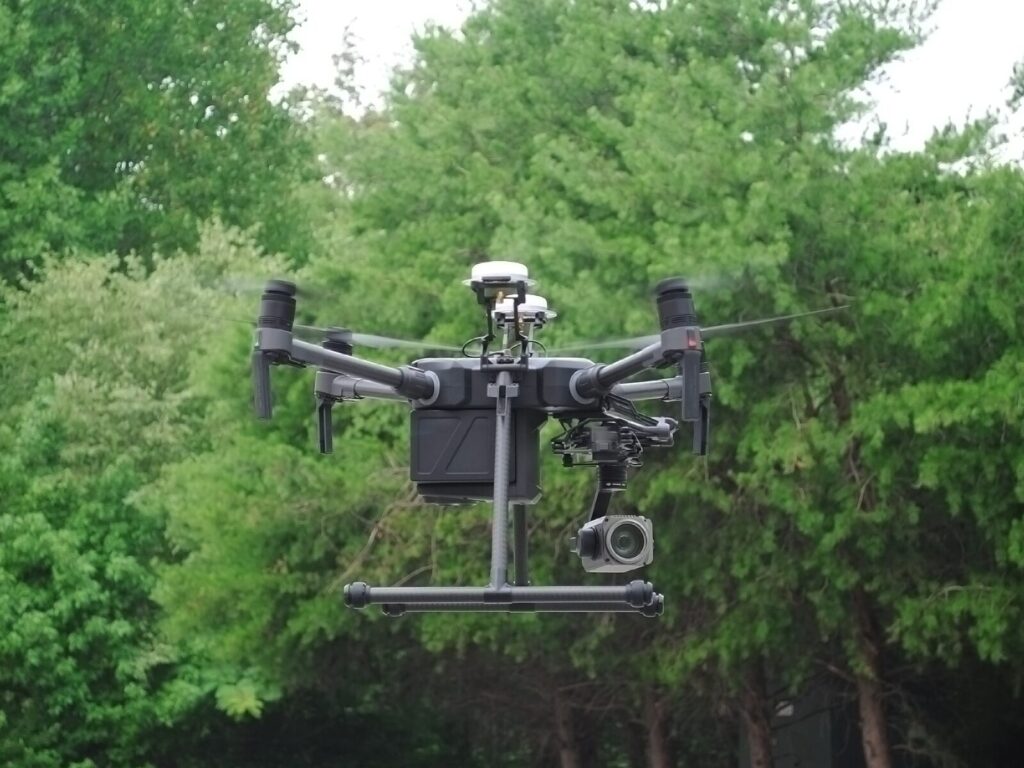Applied Technical Services offers the latest methods of assessing the condition of our clients’ buildings, structures, machines, and other large assets in the most efficient and complete manner: industrial drone inspections.
Industrial companies of all specialties use an array of complex machinery to generate their product on a massive scale. They need their equipment to work exactly as intended ad infinitum to avoid:
- falling production levels
- lost productivity
- staggering repair costs
- preventable onsite injuries
Regularly scheduled inspections help ensure that industrial companies react in a timely and appropriate manner to any flaws, damage, or other trouble that may be undermining the performance of their equipment.
Conventional methods of industrial inspection are comparatively inefficient. Take for instance diagnosing an issue with a plant’s rafter system or the roof tubes of a boiler; the conventional method for inspecting these areas of concern involves scaffolding, which requires significant preparation to erect, ratchets up the price for the client, and introduces intrinsic risk for the inspector — not to mention the risk and requirements of performing confined space entry (CSE).
By using drones, also referred to as UAVs (unmanned aerial vehicles) or sUASs (small unmanned aircraft systems), ATS Engineering has streamlined the process of inspecting areas that humans find difficult to access. Technicians can easily examine the hypothetical problem areas using our highly maneuverable drone units without ever personally leaving the ground. Unique among drone inspection companies, ATS uses in-house API certified inspectors and professional engineers as our pilots and camera operators; this allows our technicians to provide not only data on but also solutions to the issues they discover during the inspection.
Our drones are suitable for not only external, GPS-enabled environments (outdoors) but also internal, non-GPS-enabled environments (indoors). We can use our units to perform industrial drone inspections inside a confined space without requiring an operator to undergo a full CSE. Alternatively, technicians can use internal inspection UAVs to complement our manned internal inspections in lieu of scaffolding and other means of access.
External Inspection Drones
For GPS-enabled environments, ATS employs several different drone systems depending on the inspection scope and will typically use more than one on any given job. Our external inspection units use Real Time Kinematics (RTK) to provide centimeter-accurate global positioning. RTK helps prevent loss of flight capability in environments with high electrical activity (e.g., large metal structures and industrial machinery).
The high-definition cameras can be either top- or bottom-mounted to allow for examination of structures from above or below. Alternatively, they may be swapped out for thermal imaging cameras that provide simultaneous images and video.
Internal Inspection Drones
Much like external inspections, technicians performing an internal drone inspection will assess the circumstances, including the inspection scope, to determine which unit or group of units is most appropriate for the job. Non-GPS-enabled environments present a challenge when navigating UAVs — a challenge that ATS overcomes using one of two types of technology: LiDAR (light detection and ranging) and collision-tolerant systems.
LiDAR Equipped
Designed specifically for internal inspection, this advanced UAV / sUAS uses a high definition camera that swivels 180° vertically to take shots from above or below with ease. The unit’s navigation system is powered by LiDAR, which is used to both avoid collisions and navigate without a GPS connection. In addition, ATS can accurately measure any defects remotely by using the drone’s measurement and mapping capabilities. Beyond just locating a problem, ATS inspectors use this drone to characterize flaws for client consideration — all within a single flight.
Collision Resistant
In tight quarters that might require CSE for an inspector to access (such as inside a small tank), ATS may be able to use a collision-tolerant UAV to inspect the interior without physically entering the tank. Extending the controller’s signal range allows the unit to go inside vessels and ducts, from which it can feed live footage to the technician piloting from outside. During its flight, the unit captures both visual light and infrared thermal images for documentation. ATS can use the data gathered this way to make certain determinations about the condition of the tank.
Regulations in Commercial Drone Use
In response to an exploding interest in drone technology and its potential uses in commercial services, the Federal Aviation Administration (FAA) enacted a set of regulations to ensure safe and orderly airways. ATS observes the following rules when conducting an industrial drone inspection:
- Our drones are registered with the FAA under part 107
- Technicians in control of the unit are FAA licensed to pilot a UAV for commercial use
- Outdoor flights are performed solely within the pilot’s field of vision
- Drones are piloted at less than the regulatory maximum speed of 100 mph
- All units weigh less than 55 lbs upon takeoff (including ballast and payload)
- No pilot operates a drone from a moving vehicle
- Pilots never fly directly over anyone’s head
About Our Drone Inspection Services
Over the course of our 50+ years in business, ATS has grown to provide engineering consulting, inspection, and testing services to clients around the world. We have continually improved and expanded our capabilities since 1967, now allowing us to serve companies from a variety of industries. Those industries that would benefit the most from cheaper, more efficient inspections for their industrial equipment include:
- Automotive
- Aerospace
- Chemical
- Commercial Properties
- Communications
- Construction
- Manufacturing
- Military
- Nuclear
- Oil/Gas
- Power Generation
- Pulp and Paper
- Steel and Aluminum
ATS’ drone-assisted visual inspection services are provided by a team of technicians. One pilot, who is licensed by the FAA for commercial UAV use, operates the drone itself while a separate expert camera operator shoots images and video. These two technicians then view the collected footage to compose a report on their findings, which will include information like areas of concern, suggested preventive maintenance tasks, and necessary repairs. Our teams of API certified tank, vessel, and piping inspectors, AWS certified welding inspectors (CWI), ASNT certified Level I, II, and III nondestructive testing experts, and professional engineers are familiar with performing a variety of inspections to numerous standards should initial findings warrant closer investigation of specific items.
ATS Strives to Provide a Quality Customer Experience
ATS takes steps to ensure a positive customer experience. By providing quality results — namely: accurate, clear, and detailed reporting — we seek to continually reaffirm to our clients that they made the right choice when they chose to work with us. Furthermore, ATS pledges to deliver the inspection results within short turnaround window so that clients can act quickly on time-sensitive information. Our knowledgeable technicians provide excellent customer service by keeping in constant communication with the clients throughout the project. These experts remain accessible, engaged, and responsive to clients voicing questions or concerns about the status of any UAV inspection or report they received from ATS.
If your company needs industrial drone inspection services, contact ATS today — We take a closer look!



